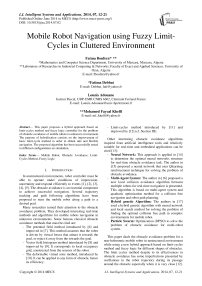Mobile Robot Navigation using Fuzzy Limit-Cycles in Cluttered Environment
Автор: Fatma Boufera, Fatima Debbat, Lounis Adouane, Mohamed Faycal Khelfi
Журнал: International Journal of Intelligent Systems and Applications(IJISA) @ijisa
Статья в выпуске: 7 vol.6, 2014 года.
Бесплатный доступ
This paper proposes a hybrid approach based on limit-cycles method and fuzzy logic controller for the problem of obstacle avoidance of mobile robots in unknown environment. The purpose of hybridization consists on the improvement of basic limit-cycle method in order to obtain safe and flexible navigation. The proposed algorithm has been successfully tested in different configurations on simulation.
Mobile Robot, Obstacle Avoidance, Limit-Cycles Method, Fuzzy Logic
Короткий адрес: https://sciup.org/15010577
IDR: 15010577
Список литературы Mobile Robot Navigation using Fuzzy Limit-Cycles in Cluttered Environment
- Brooks, R.A. 1986. A Robust Layered Control System for a Mobile Robot. IEEE Journal of Robotics and Automation, RA-2, pp.14-23.
- HachourOuarda, “Intelligent Autonomous Path Planning Systems,” International Journal of Systems Applications, Engineering and Development, Issue 3, Vol. 5, pp. 377-386, 2011.
- Adouane, L and LeFort-Piat N. 2004. Hybrid Behavioral Control Architecture for theCooperation of Minimalist Mobile Robots, In Proceedings of the International Conferenceon Robotics and Automation ICRA04. pp. 3735-3740, New Orleans-USA.
- Meyer, J.A, and D. Filliat. 2003. Map-based navigation in mobile robots, a review of map-learning and path-planning strategies. Journal of Cognitive Systems Research, 4(4):283317.
- Luzeaux, D, and A. Dalgalarrondo. 2003. Hybrid architecture for autonomous robot based on representation, perception and intelligent control. Studies in Fuzziness and Softcomputing. Recent Advances in Intelligent Paradigms and Applications. ISBN 3-7908- 1538.
- Khatib M. and H. Jaouni, R. Chatila& J.P. Laumond. Dynamic Path Modi_cation for Car-Like Nonholonomic Mobile Robots. IEEE International Conference on Robotics and Automation, pages 2920_2925. Albuquerque, USA, 1997.
- Khatib, O. 1986. Real time obstacle avoidance for manipulators and mobile robots. Internationaljournal roboticsresearch, 5(1), 90-80.
- Koren, Y, and J. Borensrein. 1991. Potential Field Methods and their inherent limitations for mobile robot navigation. IEEE conference on robotics and automation, PP.1398-1404.
- Ulrich, B. 1998. Reliable obstacle avoidance for fast mobile robots. in IEEE intconf on robotics and automation. Leuven, Belgium.
- Zapata, R, and P. Lepinay. 1994. Reactive behaviors of fast mobile robots. Journal ofrobotics system, vol.11, pp. 13-20.
- Kim, D, and J. Kim. 2003. A real-time limit-cycle navigation method for fast mobilerobots and its application to robot soccer, Robotics and Autonomous Systems, vol. 42, pp.17-30.
- Adouane, L. 2009. Orbital obstacle avoidance algorithm for reliable and on-line mobile robot navigation. In Proceedings of the In 9th Conference on Autonomous Robot Systems and Competitions.
- Adouane, L, and A. Benzerrouk, and P. Martinet. 2011, Mobile Robot Navigation in cluttered Environment using Reactive Elliptic Trajectories, In Proceedings of the 18th IFAC World Congress, Milano-Italy,August 2011.
- Hoang, T and T. Nguyen. 2007. Obstacle Avoidance for Power Wheelchair Using Bayesian Neural Network, Proceedings of the 29th Annual International, Conference of the IEEE EMBS, CitéInternationale, Lyon, France, August 23-26, 2007.
- Duguleana, M, and F. Barbuceanua, and A.Teirelbarb, and G.Mogana. 2012. Obstacleavoidance of redundant manipulators usingneuralnetworks based reinforcement learning, Robotics and Computer-Integrated Manufacturing, Volume 28, Issue 2, April 2012, Pages 132146.
- Guy, S, and J.Chhugani and C.Kim and N.Satish and M.Lin and D. Manocha andP.Dubey. 2009. ClearPath: Highly Parallel Collision Avoidance for Multi-Agent Simulation.Eurographics/ ACM SIGGRAPH Symposium on Computer Animation (2009), E.Grinspun and J. Hodgins (Editors).
- Hosseinzadeh, A and H.Izadkhah. 2010.Evolutionary Approach for Mobile Robot Path Planning in Complex environment, IJCSI International Journal of Computer Science Issues,Vol. 7, Issue 4, No 8, July 2010.
- Couceiro, M.S, and R.P. Rocha and N.M.F. Ferreira. 2011. A novel multi-robot exploration approach based on Particle Swarm Optimization algorithms. Safety, Security, and Rescue Robotics (SSRR), 2011 IEEE International Symposium on.
- Benzerrouk, A,Adouane, L. and Martinet, P. 2010, Lyapunov Global Stability for a Reactive Mobile Robot Navigation in Presence of Obstacles Braitenberg, V. 1984. Vehicles. MIT Press, Cambridge MA.
- Saffotti, A. and E. Ruspini H, and K. Konolige. 1999. Using fuzzy logic for mobile robotcontrol. In: Zimmermann HJ, editor. Practical applications of fuzzy technologies, KluwerAcademic; p.185-206.
- Lee, and Wang. 1994. Collision Avoidance by Fuzzy Logic Control for Automated guidedVehicle Navigation, Journal of Robotics Systems, Vol. 11 No.8, pp 743-760.
- Aguirre, E, and A. Gonzalez. 2000. Fuzzy behaviors for mobile robot navigation: Design, coordination and fusion. International Journal of Approximate Reasoning, Vol. 25, No. 3, 255-289.
- Xu, W.L. 2000. A virtual target approach for resolving the limit cycle problem in navigationof a fuzzy behavior-based mobile robot. Ibid, Vol. 30,315-324.
- Zavlangas, P.G, and S.G. Tzafestas, and K. Althoefer. 2000. Fuzzy obstacle avoidanceand navigation for omnidirectional mobile robots. In Proceedings of the ESIT 2000, Aachen,German.
- Saffoti, A, 1997, the uses of fuzzy logic in autonomous robot navigation, Soft computing, pp 180-297, 1997
- Seraji H, 2000, Fuzzy Traversability Index: A new concept for terrain-based navigation, Journal of Robotic Systems, 17(2), pp. 75-91, 2000.
- Kanakakis, V. Valavanis, K. P. & Tsourveloudis, N. C. (2004). Fuzzy-Logic Based Navigation of Underwater Vehicles. Journal of Intelligent and Robotic Systems, Vol. 40,45-88.
- Moustris, G., & Tzafestas, S. 2005. A Robust Fuzzy Logic Path Tracker for Non-holonomic Mobile Robots. International Journal on Artificial Intelligence Tools,14 (6), (2005), pp.935-966
- Menon M., Muhletaler F., Campos M., Peabody J.O. (2008) Assessment of early continence after reconstruction of the periprostatic tissues in patients undergoing computer assisted (robotic) prostatectomy: results of a 2 group parallel randomized controlled trial. J Urol 180: 1018–1023
- Boubertakh H, Tadjine M, et al. 2010. Tuning fuzzy PD and PI controllers using reinforcement learning. ISA Trans 49 (4): 543-51.
- Mamdani, E.H. 1977. Application of Fuzzy Logic to Approximate Reasoning Using LinguisticSunthesis. IEEE Transactions on Computers, Vol. C-26, No. 12.


